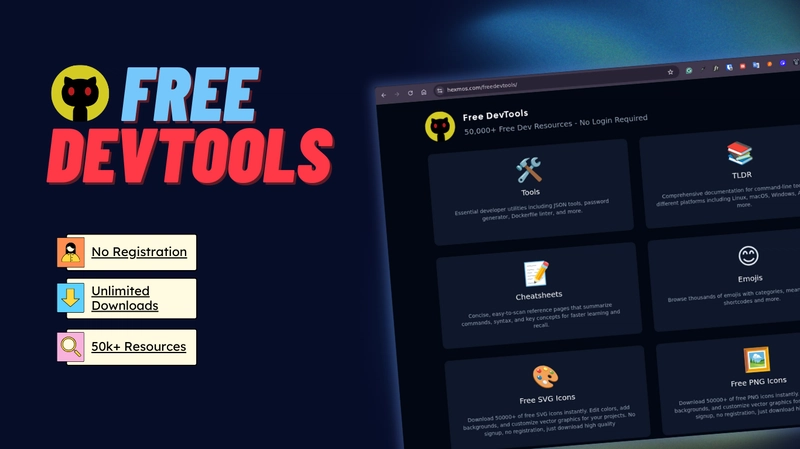Hello, I’m Maneshwar. I’m working on FreeDevTools online currently building *one place for all dev tools, cheat codes, and TLDRs* — a free, open-source hub where developers can quickly find and use tools without any hassle of searching all over the internet.
Before diving into next-sitemap, it’s helpful to recall why sitemaps and robots.txt are valuable:
- A sitemap.xml (or a set of sitemaps) helps search engines (Google, Bing, etc.) discover the URLs in your site, know when pages change (via
- A robots.txt file tells crawlers which paths they should or should not access. It can also point to the sitemap(s).
- For modern frameworks like Next.js, which may have a mix of static pages, dynamic routes, server-side generated pages, etc., manually maintaining sitemap + robots.txt can be error-prone and tedious.
next-sitemap automates this process for Next.js apps, generating sitemaps and robots.txt based on your routes and configuration.
The GitHub README describes it as: “Sitemap generator for next.js. Generate sitemap(s) and robots.txt for all static/pre-rendered/dynamic/server-side pages.”
At a high level, next-sitemap is a utility that:
- Parses your project (static, dynamic, SSR routes) and produces sitemap XML files (splitting if needed, indexing, etc.).
- Optionally creates a
robots.txtfile that references the sitemap(s) and defines crawl rules (Allow, Disallow). - Provides hooks/customizations (transform, exclude, additional paths, custom policies).
- Supports server-side dynamic sitemaps in Next.js (via API routes or Next 13 “app directory” routes).
Thus, instead of manually writing and updating your sitemap + robots.txt as your site evolves, you let next-sitemap keep them in sync automatically (or semi-automatically) based on config.
Some key benefits:
- Less manual work / fewer mistakes: You don’t need to hand-craft XML or remember to update robots whenever routes change.
- Consistency: The tool standardizes how your sitemap and robots are built.
- Scalability: It can split large sitemap files, index them, and handle dynamic route generation.
- Flexibility: You can override behavior (exclude some paths, set different priorities, add extra sitemap entries, control crawl policies).
- Next.js integration: Works with both “pages” directory and new “app” directory / Next 13+, and supports server-side generation APIs for dynamic content.
In short: next-sitemap is the bridge between Next.js routes and proper SEO-friendly sitemap & robots files.
Installing and basic setup
Here is a step-by-step for getting started.
1. Install the package
yarn add next-sitemap
# or npm install next-sitemap
2. Create a config file
At the root of your project, add next-sitemap.config.js (or .ts). A minimal example:
/** @type {import('next-sitemap').IConfig} */
module.exports = {
siteUrl: process.env.SITE_URL || 'https://example.com',
generateRobotsTxt: true, // whether to generate robots.txt
// optionally more options below...
}
By default, generateRobotsTxt is false, so if you want a robots.txt, you must enable this.
3. Hook it into your build process
In your package.json:
{
"scripts": {
"build": "next build",
"postbuild": "next-sitemap"
}
}
So after the Next.js build step, the next-sitemap command runs to generate the sitemap(s) and robots.txt.
If you’re using pnpm, due to how postbuild scripts are handled, you might also need a .npmrc file containing:
enable-pre-post-scripts=true
This ensures that the postbuild script runs properly.
4. Output placement & indexing
By default, the generated files go into your public/ folder (or your outDir) so that they are served statically.
next-sitemap v2+ uses an index sitemap by default: instead of one big sitemap.xml listing all URLs, you get sitemap.xml that references other sitemap-0.xml, sitemap-1.xml, etc., if split is needed.
If you prefer not to use an index sitemap (for simpler / small sites), you can disable index generation:
generateIndexSitemap: false
Configuration options: customizing lastmod, priority, changefreq, splitting, excludes, etc.
To make your sitemap more useful, next-sitemap offers many configuration options. Here are the common ones and how to use them.
| Option | Purpose | Default | Example / notes |
|---|---|---|---|
siteUrl |
Base URL of your site (e.g. https://yourdomain.com) |
— | Required |
changefreq |
Default daily, weekly) |
"daily" |
You can also override per-path via transform function |
priority |
Default |
0.7 |
Also override per-path if needed |
sitemapSize |
Max number of URLs in a single sitemap file before splitting | 5000 |
Set to e.g. 7000 to allow 7,000 URLs per file ([GitHub][1]) |
generateRobotsTxt |
Whether to produce robots.txt file |
false |
If true, robots.txt will include sitemap(s) and your specified policies |
exclude |
List of path patterns (relative) to omit from sitemap | [] |
e.g. ['/secret', '/admin/*']
|
alternateRefs |
For multilingual / alternate URLs (hreflang) setup | [] |
Provide alternate domain/hreflang pairs |
transform |
A custom function called for each path to allow modifying or excluding individual entries | — | If transform(...) returns null, the path is excluded; else return an object that can include loc, changefreq, priority, lastmod, alternateRefs etc. ([GitHub][1]) |
additionalPaths |
A function returning extra paths to include in sitemap (beyond routes detected) | — | Useful if some pages are not part of route detection but still should be in sitemap ([GitHub][1]) |
robotsTxtOptions |
Customization for robots.txt (policies, additionalSitemaps, includeNonIndexSitemaps) | — | See below for details |
Example full config
Here is an example combining many features:
/** @type {import('next-sitemap').IConfig} */
module.exports = {
siteUrl: 'https://example.com',
changefreq: 'weekly',
priority: 0.8,
sitemapSize: 7000,
generateRobotsTxt: true,
exclude: ['/secret', '/protected/*'],
alternateRefs: [
{ href: 'https://es.example.com', hreflang: 'es' },
{ href: 'https://fr.example.com', hreflang: 'fr' }
],
transform: async (config, path) => {
// Suppose you want to exclude admin pages
if (path.startsWith('/admin')) {
return null
}
// For blog posts, boost priority
if (path.startsWith('/blog/')) {
return {
loc: path,
changefreq: 'daily',
priority: 0.9,
lastmod: new Date().toISOString(),
alternateRefs: config.alternateRefs ?? []
}
}
// default transformation
return {
loc: path,
changefreq: config.changefreq,
priority: config.priority,
lastmod: config.autoLastmod ? new Date().toISOString() : undefined,
alternateRefs: config.alternateRefs ?? []
}
},
additionalPaths: async (config) => {
// Suppose you have pages not automatically discovered
return [
await config.transform(config, '/extra-page'),
{
loc: '/promo',
changefreq: 'monthly',
priority: 0.6,
lastmod: new Date().toISOString()
}
]
},
robotsTxtOptions: {
policies: [
{
userAgent: '*',
allow: '/'
},
{
userAgent: 'bad-bot',
disallow: ['/private', '/user-data']
}
],
additionalSitemaps: [
'https://example.com/my-extra-sitemap.xml'
],
includeNonIndexSitemaps: false // whether to include all sitemap endpoints
}
}
That config would produce:
- A sitemap index file (
sitemap.xml) referencing sub-sitemaps. - Specific
blog/*routes get higher priority and daily changefreq. - Admin pages get excluded entirely.
-
robots.txtthat includes your custom policies and additional sitemaps.
Understanding lastmod, priority, changefreq
These three XML elements are often misunderstood. Here’s how they work and how next-sitemap uses them:
-
autoLastmod: true(default), next-sitemap will set it to the current timestamp (ISO) for all pages. You can override it per path intransformor viaadditionalPaths. -
-
daily,weekly,hourly). It’s a signal, not a binding contract — search engines may ignore if they see no change.
In your config, you can set defaults and then override for specific paths.
Handling large sites: splitting sitemaps & indexing
If your site has many URLs (e.g. 10,000, 100,000), having a single sitemap.xml can be unwieldy. next-sitemap helps via:
-
sitemapSize: sets the max number of URLs per sitemap file. If exceeded, it automatically splits into multiple files (e.g.sitemap-0.xml,sitemap-1.xml). - Then it creates a “index sitemap” (
sitemap.xml) which references all the sub-sitemaps. - If you don’t want that complexity, you can disable index mode with
generateIndexSitemap: false.
This ensures your site’s sitemap stays manageable and within recommended limits.
Server-side / dynamic sitemap support (Next.js 13 / app directory)
One challenge: what if your site has many dynamic pages (e.g. blog posts fetched from a CMS) that aren’t known at build time? next-sitemap provides APIs to generate sitemaps at runtime via server routes.
These APIs include:
-
getServerSideSitemapIndex— to generate an index sitemap dynamically (for the “app directory” in Next 13) -
getServerSideSitemap— to generate a sitemap (list of - Legacy versions (for pages directory) are also supported (e.g.
getServerSideSitemapLegacy)
Example: dynamic index sitemap in app directory
Create a route file like app/server-sitemap-index.xml/route.ts:
import { getServerSideSitemapIndex } from 'next-sitemap'
export async function GET(request: Request) {
// fetch your list of sitemap URLs or paths
const urls = [
'https://example.com/sitemap-0.xml',
'https://example.com/sitemap-1.xml'
]
return getServerSideSitemapIndex(urls)
}
Then in your next-sitemap.config.js, exclude '/server-sitemap-index.xml' from static generation, and add it to robotsTxtOptions.additionalSitemaps so that the generated robots.txt points to this dynamic index.
Example: dynamic sitemap generation
Similarly, for an actual sitemap of dynamic URLs:
In app/server-sitemap.xml/route.ts:
import { getServerSideSitemap } from 'next-sitemap'
export async function GET(request: Request) {
const fields = [
{
loc: 'https://example.com/post/1',
lastmod: new Date().toISOString(),
// optionally, changefreq, priority
},
{
loc: 'https://example.com/post/2',
lastmod: new Date().toISOString()
},
// etc.
]
return getServerSideSitemap(fields)
}
Again, exclude '/server-sitemap.xml' in your static config and add it to robotsTxtOptions.additionalSitemaps.
This way, your dynamic content remains discoverable by crawlers even if not known at build time.
robots.txt: policies, inclusion, additional sitemaps
When generateRobotsTxt: true, next-sitemap will generate a robots.txt file for your site (placed under public/). Some details:
- By default, it will allow all paths to all user agents (
User-agent: * Allow: /) unless you override. - It will include the
Sitemap: …line(s), pointing to your index sitemap (or multiple sitemaps) so that crawlers know where to look. -
You can customize via
robotsTxtOptions:-
policies: an array of policy objects, e.g.:
[ { userAgent: '*', allow: '/' }, { userAgent: 'special-bot', disallow: ['/secret'] } ]-
additionalSitemaps: If you have other sitemaps not auto-generated by next-sitemap (for example an external sitemap), you can include them. -
includeNonIndexSitemaps: from version 2.4.x onwards, this toggles whether all sitemap endpoints (not just the index) are listed in the robots.txt. Setting it tofalsehelps avoid duplicate submissions (index → sub-sitemaps → repeated).
-
Sample robots.txt output
With a config like:
robotsTxtOptions: {
policies: [
{ userAgent: '*', allow: '/' },
{ userAgent: 'bad-bot', disallow: ['/private'] }
],
additionalSitemaps: ['https://example.com/my-custom-sitemap.xml']
}
You might get:
#
User-agent: *
Allow: /
# bad-bot
User-agent: bad-bot
Disallow: /private
# Host
Host: https://example.com
# Sitemaps
Sitemap: https://example.com/sitemap.xml
Sitemap: https://example.com/my-custom-sitemap.xml
Example end-to-end: sample Next.js / next-sitemap workflow
Putting it all together, here’s a possible workflow:
- Install
next-sitemapin your Next.js project. - Create
next-sitemap.config.jswith settings and customize as needed (site URL, policies, exclusions, transforms). - Add
postbuild: next-sitemapin your build script so sitemaps and robots are generated after building. - If you have dynamic content not known at build time, add server-side routes using
getServerSideSitemap/getServerSideSitemapIndex. - Exclude those dynamic sitemap paths from static generation in config, and include them in
robotsTxtOptions.additionalSitemaps. - Deploy your site. The generated
sitemap.xml,sitemap-0.xml, etc., androbots.txtare publicly accessible (e.g.https://yourdomain.com/robots.txt). - Submit your
sitemap.xml(or index) to Google Search Console / Bing Webmaster, so search engines know where to crawl from.
I’ve been building for FreeDevTools.
A collection of UI/UX-focused tools crafted to simplify workflows, save time, and reduce friction in searching tools/materials.
Any feedback or contributors are welcome!
It’s online, open-source, and ready for anyone to use.
👉 Check it out: FreeDevTools
⭐ Star it on GitHub: freedevtools




